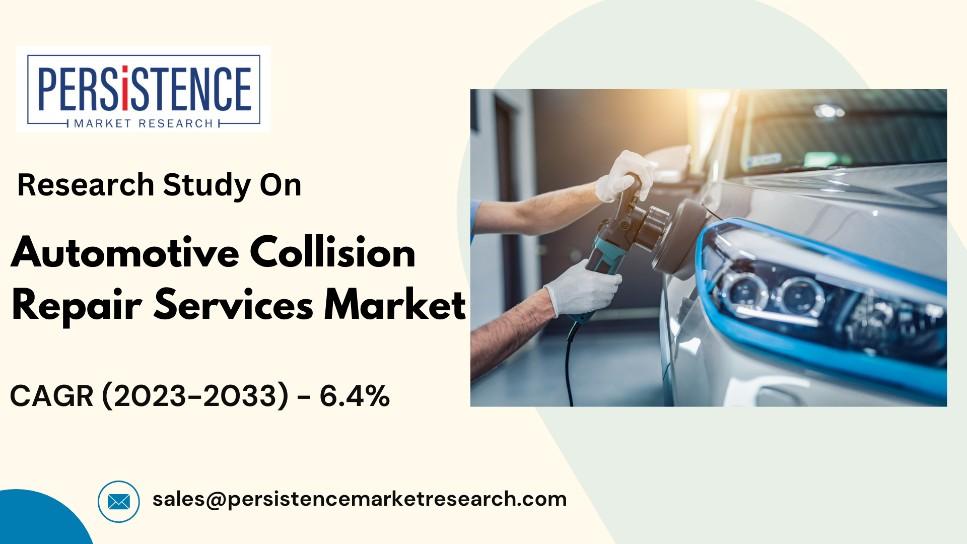Strategic Insights into the Automotive Collision Repair Services Market
The Automotive Collision Repair Services Market, valued at USD 123.9 billion in 2022, is projected to reach USD 230.4 billion by 2033, growing at a CAGR of 6.4% from 2023 to 2033. The market's growth is driven by advancements in shop technology, rising customer expectations for vehicle longevity, and an increase in vehicle accidents due to inadequate infrastructure. Key factors contributing to this growth include the rising number of young, educated vehicle owners prioritizing maintenance and repair, and the growing vehicle parc globally. Additionally, the increase in vehicle insurance rates, supported by government regulations, has further propelled repair activities. Historically, the market grew at a CAGR of 1.9% from 2017 to 2022, with Europe and East Asia holding significant shares. The sector's expansion is also fueled by new technologies and infrastructure development, which enhance repair and maintenance services.

Rising Vehicle Ownership: As global vehicle ownership continues to increase, particularly in emerging markets, the demand for collision repair services is expanding. Higher vehicle numbers lead to more frequent accidents and, consequently, a greater need for repair services.
Technological Advancements: Innovations in repair technologies, such as computerized diagnostics, 3D imaging, and advanced materials, are transforming the collision repair industry. These advancements enhance repair accuracy, efficiency, and service quality, driving market growth.
Complex Vehicle Designs: The growing complexity of vehicle designs, including advanced materials and electronics, is creating demand for specialized repair services. Repair shops must invest in new technologies and training to handle modern vehicles effectively.
Urbanization and Infrastructure Development: Rapid urbanization and infrastructure development contribute to increased traffic and accident rates, boosting the demand for collision repair services. Expanding urban areas and new infrastructure projects create opportunities for repair service providers.
Market Challenges
High Equipment Costs: The cost of advanced repair technologies and equipment can be a barrier for smaller repair shops. Investing in state-of-the-art tools and systems requires significant capital, which can be challenging for some businesses.
Skilled Labor Shortage: The automotive collision repair industry faces a shortage of skilled technicians. As vehicle technology evolves, repair shops need to invest in ongoing training and development to ensure their staff can handle new repair challenges.
Regulatory Compliance: Compliance with evolving regulatory standards, such as those related to safety and environmental impact, can be complex and costly. Repair shops must stay updated with regulations and ensure their practices meet industry standards.
Strategic Opportunities
Digital Transformation: Embracing digital tools and technologies, such as estimating software, repair management systems, and customer relationship management (CRM) platforms, can enhance operational efficiency and customer service. Digital transformation is key to staying competitive in the evolving market.
Expansion and Consolidation: Mergers, acquisitions, and network expansion are effective strategies for growth. Companies can increase their market presence and operational capabilities by acquiring regional repair centers or partnering with other industry players.
Focus on Customer Experience: Improving customer service and satisfaction can differentiate repair shops in a competitive market. Offering value-added services, such as convenient appointment scheduling, transparent pricing, and high-quality repairs, can attract and retain customers.
Sustainability Initiatives: Incorporating sustainability practices, such as using eco-friendly materials and reducing waste, can enhance a company's reputation and appeal to environmentally conscious consumers. Sustainability initiatives also help repair shops comply with regulatory requirements and reduce operational costs.
Regional Insights
North America: The North American market, led by the United States and Canada, is characterized by a mature repair infrastructure and high vehicle ownership rates. Companies are focusing on technological innovation and network expansion to maintain their competitive edge.
Europe: The European market is driven by stringent safety and quality regulations. Companies in this region are investing in advanced repair technologies and compliance with regulatory standards to meet consumer expectations and industry requirements.
Asia-Pacific: The Asia-Pacific region, including China, India, and Japan, is experiencing rapid growth in vehicle ownership and urbanization. This growth presents significant opportunities for collision repair service providers to expand their operations and tap into emerging markets.
Latin America and Africa: Emerging markets in Latin America and Africa are seeing increased demand for collision repair services due to rising vehicle ownership and economic development. Companies are focusing on expanding their presence and establishing repair networks in these regions.
